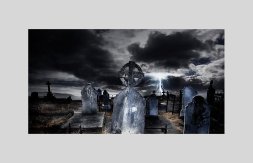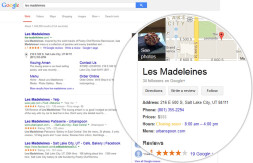7 Conversion Lessons Learned From Eye Tracking

You’ve seen those eye tracking reports before, but have you ever run one? Chances are you haven’t. Although they are costly and time-consuming, you can actually learn a lot from them.
One thing I’ve learned by studying them is that there are a lot of commonalities in how people move their eyes, no matter what website they are on. If you take eye tracking data and apply it to your site, you’ll be able to improve your conversion rate.
Here are 7 things you can learn from eye tracking:
Lesson #1: Be careful how you use people
Those stock photo sites are notorious for having thousands, if not millions, images of people. And there is a good chance that you’ll use a picture of someone on your website. But did you know that using images of people incorrectly can decrease your conversion rate?

If you look at the image above, you’ll notice that the person is looking at you. Because she is looking at you, you are very likely to look back at her, and not the product.

Now, if you look at this version of the Sunsilk ad, you’ll notice that the female in the picture is looking at the product. Nothing really changed in the image, other than her eyes. Eye tracking shows that the direction of the model’s gaze forces you to look more at the product.
The same thing goes for calls to actions. If you are going to use images of people, make sure their eyes are looking at your most important web page element such as forms and call-to-action buttons.
Lesson #2: People love media
From pictures to videos, people love media. If you put media on a page, people are more likely to focus on it compared to the text on the page. Just look at how you used to look at Google search results before they started adding images and videos.
![]()
And here is what happened to your eyes when they added video:
![]()
And here is what happened to your eyes when they added images of products to their search results:
![]()
What you should take away from this is that media can be good, but you have to be careful with how you use it. If you are using media to help sell your products or services, that’s great. But if the media is a distraction, then you’ll decrease your conversion rates.
Lesson #3: Know your target market
Did you know that women and men look at different things? Let me explain…

Stare at the image above for just a minute. Can you guess what men looked at versus what women looked at? If you look at the image below, you’ll notice that men looked at the chest area more than women.

That may seem obvious to you, but if you look at the image below, you’ll notice that women focused their eyes on the ring finger.

The purpose of this eye tracking lesson is to help you understand that women look at images and web pages differently than men. Although it would be very difficult to detect if your visitor is a man or woman, you might be able to focus your conversion optimization efforts towards one gender.
For example, Timothy Sykes knows that 98% of his customers are men. So, he focuses all of his conversion optimization and marketing tactics around men.
Now, granted, your customer profile is probably not as skewed to the male or female audience like Tim’s is, but even if 70% or more of your customers are skewed to one gender, you can potentially boost your revenue by focusing all of your conversion efforts on that one gender.
If you are unsure of the overall demographics of your visitors, you can use Survey Monkey or Qualaroo to figure out if your visitors are male or female.
Lesson #4: Simplicity is the ultimate sophistication
Where you place your text, images, products and even call-to-action buttons matters. We went over how images of people’s eyes can affect where you look, but simplifying things can help too.

If you look at the image above, you’ll notice that your eyes focus on the person’s nose, the phone and the Prada logo. The photographer created a natural viewing flow by keeping the photo simple.
You can do the same with your design to boost your conversion rates. Removing unnecessary elements or text on your web page and reducing how many different colors you use within your design will make it easier to control what people do.
Lesson #5: People read left to right
Did you know that people stay on web pages only for 10 to 20 seconds before they leave? Based on the fact that most people can read 250 words a minute, an average person reads 40 to 80 words before they leave a page.
The average web user also spends 69% of their time looking at the left side of a web page, which means that your most important elements need to be placed on the left-hand side of a web page.

Your most important message should be at the top of your web page and, ideally, on the left side. I know this sounds like common sense, but there are way too many sites out there that forget to put important elements like call-to-action buttons or even form fields higher on the web page towards the left side.
You’ll have to test what works best for you, but placing important elements on the left side and limiting the amount of text you use will give you a good start.
Lesson #6: Faces matter
You know eye placement affects what you look at, but did you know that body positioning can make even a bigger impact than eye movement?
Just look at the images below:


As you can see, the strategic placement of the baby face, the product description and the image on the page draws your attention to the product. If you are considering using images of people on your landing pages, don’t just have them look at your product or service, have their whole body face it. Heck, if you can get them to point their finger to your call to action, that may help boost your conversion rate even more.
Again, you’ll have to test this out, but the initial results that I’ve seen tend to work well. KimberlySnyder.net recently did an A/B test of their homepage in which they used an image of a person that faced a call to action button.

The results were a 13% increase in conversions.
Lesson #7: People love handwritten notes
Do you remember writing and drawing notes as a kid? You know, hand-drawn messages like these:

Believe it or not, when people read these doodles or messages, it causes them to look at whatever you want them to look at. You just have to make sure to include hand-drawn arrows in your message.

Just look at this live site for a moment. Once you do, it will make sense why people are focusing their eyes on the top left in the image above. It’s because the hand-drawn message told them to.
Whether you like hand-drawn messages from a design perspective or not, you should consider testing them out. If you don’t think they are effective, just go back to your childhood days when your friends passed you hand-written notes in class. Chances are you were intrigued and highly engaged when you read the hand-written message.
Conclusion
No matter what changes you make to your website, you should try to A/B test them to make sure they improve your conversion rates. Copying examples above without testing them is a bad idea… just because something worked for someone else doesn’t mean it will work for you.
If you can’t afford to do eye tracking on your site, you can try leveraging heatmaps, which produce similar results at a much lower cost. By using heatmaps or eye tracking tests on a regular basis, you should be able to come up with ideas that will help you boost your conversion rate.














